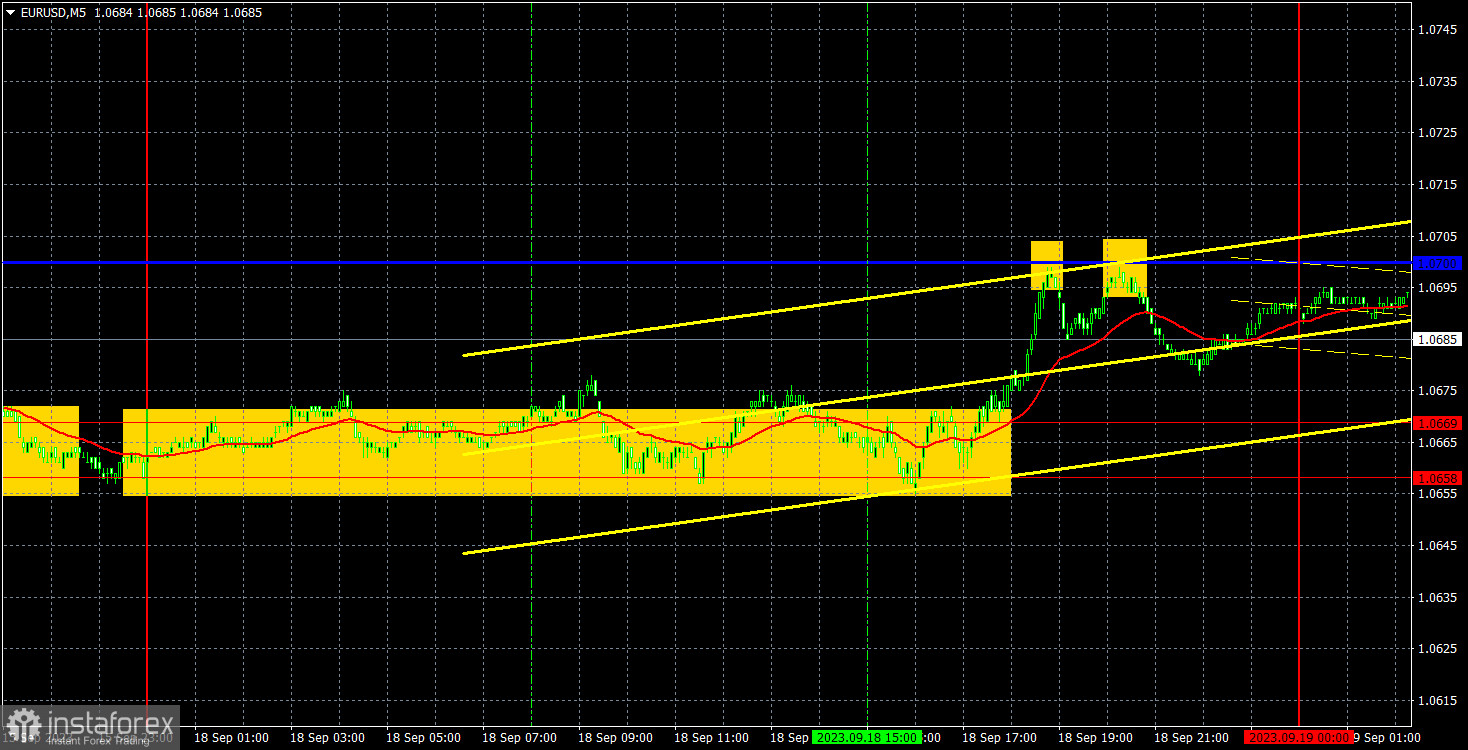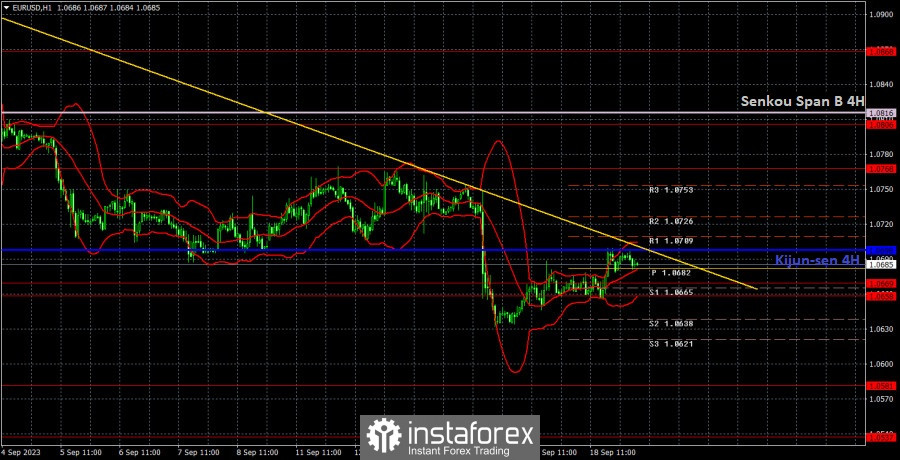Analysis of EUR/USD 5M

EUR/USD kicked off the week relatively low-key by staying flat for nearly 20 hours and rising by 25 pips towards the end of the day. Volatility was approximately 45 pips, which means that there is generally nothing to talk about. There were no significant reports in the European Union or the United States. There was nothing for traders to react to, hence the low volatility and the absence of any significant moves. As a result, we couldn't draw any conclusions from Monday's results. The pair aims to enter a bullish correction, but it will take a very long time to correct by just 20 pips. On Wednesday evening, the results of the Federal Reserve meeting will be announced, so both the dollar and the euro may appreciate, and volatility should also increase.
Is there any point in discussing trading signals based on Monday's results? Formally, the price managed to settle above the 1.0658-1.0669 range in the middle of the US session and even rose towards a critical line from which it rebounded twice. Therefore, the most that traders could have done was to open a long position with a potential profit of 15 pips. But we believe that it wouldn't have made sense to do so as the potential loss would have been higher (the stop-loss would have had to be set below 1.0658). Therefore, the best thing to do was not to enter the market.
COT report:

On Friday, a new COT report for September 12 was released. Over the last 12 months, COT reports fully corresponded to what is happening in the market. The chart above clearly shows that the net position of major traders (the second indicator) began to grow in September 2022 and at about the same time the euro started rising too. In the last 6-7 months, the net position has not risen but the euro remains at very high levels and is declining rather slowly. Nonetheless, it is still declining. Any significant decline often starts from a small one. At the moment, the net position of non-commercial traders is bullish and remains strong, but the euro is gradually falling.
I have already mentioned the fact that a fairly high value of the net position signals the end of an uptrend. Perhaps that time has come. The red and green lines are very far from each other, and they have even started to converge. Usually, it precedes the end of the trend. Therefore, we believe that the uptrend is coming to an end. During the last reporting week, the number of long positions of the non-commercial group of traders decreased by 23,300 and the number of short ones fell by 200. The net position decreased by 23,100 contracts. The number of long positions is higher than the number of short ones of non-commercial traders by 113,000but the gap is narrowing, which is a good sign. Even without COT reports, it is obvious that the euro should decline, and the COT reports support this scenario.
Analysis of EUR/USD 1H

On the 1H chart, the currency pair maintains a downtrend. It hasn't managed to correct, and there's no solid reason for strong growth. The price has approached the critical line and the trendline, so in case of a rebound, the downward may resume today. Overcoming these two lines will signal a continuation of the bullish correction to the Senkou Span B line.
On September 19, traders should pay attention to the following key levels: 1.0485, 1.0537, 1.0581, 1.0658-1.0669, 1.0768, 1.0806, 1,0868, 1.0935, 1.1043, 1.1092, as well as the Senkou Span B line (1.0816) and the Kijun-sen (1.0698). The lines of the Ichimoku indicator can move during the day, which should be taken into account when determining trading signals. There are support and resistance levels that can be used to lock in profits. Traders look for signals at rebounds and breakouts. It is recommended to set the Stop Loss orders at the breakeven level when the price moves in the right direction by 15 pips. This will protect against possible losses if the signal turns out to be false.
On Tuesday, the European Union is set to release its second inflation estimate for August, which is unlikely to differ from the first estimate, so there is no need to expect a market reaction to this report. We don't foresee any significant uptick in volatility for Tuesday.
Description of the chart:
Support and resistance levels are thick red lines near which the trend may end. They do not provide trading signals;
The Kijun-sen and Senkou Span B lines are the lines of the Ichimoku indicator, plotted to the 1H timeframe from the 4H one. They provide trading signals;
Extreme levels are thin red lines from which the price bounced earlier. They provide trading signals;
Yellow lines are trend lines, trend channels, and any other technical patterns;
Indicator 1 on the COT charts is the net position size for each category of traders;
Indicator 2 on the COT charts is the net position size for the Non-commercial group.
 English
English 
 Русский
Русский Bahasa Indonesia
Bahasa Indonesia Bahasa Malay
Bahasa Malay ไทย
ไทย Español
Español Deutsch
Deutsch Български
Български Français
Français Tiếng Việt
Tiếng Việt 中文
中文 বাংলা
বাংলা हिन्दी
हिन्दी Čeština
Čeština Українська
Українська Română
Română

